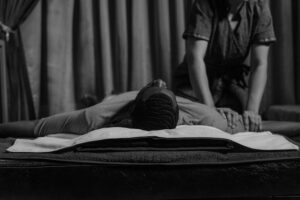Arm massage techniques are a secret to unlock ultimate relaxation and well-being. Did you know that over 80% of people report feeling significant stress and tension in their arms and shoulders? It’s no wonder that discovering the right methods can be a game-changer. In this article, we will delve into 5 incredibly beneficial arm massage techniques that can help you break free from the shackles of stress and experience the bliss of relaxation.
Whether you’re seeking relief from a busy workday or looking to enhance your overall quality of life, these techniques have got you covered. So, let’s roll up our sleeves and embark on a journey to a more relaxed and rejuvenated you. Your path to serenity begins here!
The Science of Arm Massage Techniques
When it comes to relaxation and stress relief, arm massage techniques hold a special place in the world of wellness. These techniques are not just about pampering; they are grounded in science. In this comprehensive guide, we’ll delve into the scientific foundation behind arm massage techniques, their benefits, and how they can unlock the door to ultimate relaxation.
The Physiology of Stress and Tension
Before we dive into the specifics of arm massage, let’s first understand why stress and tension accumulate in our arms. Stress is a prevalent issue in today’s fast-paced world, affecting a staggering 80% of individuals. It often manifests physically, with the shoulders and arms being prime areas of tension.
When stress triggers the “fight or flight” response, our muscles tense up, preparing us to respond to a perceived threat. However, in our modern lives, this response is frequently activated by non-life-threatening situations, leading to chronic muscle tension.
Arm Massage: A Scientific Solution
Arm massage techniques have been scientifically proven to counteract this tension. Regular massage can increase blood flow, release endorphins, and reduce the stress hormone cortisol. A study published in the “Journal of Alternative and Complementary Medicine” found that massage therapy significantly lowered cortisol levels in participants.
Related
- 5 Best Techniques for Leg Massage for Blood Circulation
- 3 Surprising Benefits of Inner Thigh Massage: Techniques Explained!
- 10 Power-Packed Techniques to Massage Tendonitis (Can massage make it worse?)
The Benefits of Arm Massage
- Stress Reduction: Research conducted at the University of Miami’s Touch Research Institute revealed that even a 15-minute arm massage can reduce stress and anxiety levels significantly.
- Pain Relief: Arm massage techniques can alleviate chronic pain conditions, such as carpal tunnel syndrome and arthritis. A study in the “Journal of Pain and Symptom Management” demonstrated the effectiveness of massage in reducing pain intensity.
- Improved Sleep: Massage triggers the release of serotonin, which plays a key role in regulating sleep. A study published in the “International Journal of Neuroscience” found that massage therapy improved sleep quality in adults.
Arm Massage Techniques: Explained
Now that we understand the scientific basis for the effectiveness of arm massage, let’s explore five popular techniques that can lead to ultimate relaxation.
1. Effleurage: Effleurage is a gentle and soothing stroke that involves gliding your hands smoothly over the surface of the skin. This technique is typically used at the beginning of an arm massage to warm up the muscles and prepare them for deeper work. Effleurage helps increase blood circulation, relaxes the recipient, and sets a calming tone for the massage session. It’s like the welcoming embrace that eases you into the experience.
2. Petrissage: Petrissage, also known as kneading, is a technique that involves lifting and squeezing the muscles gently. The therapist uses their fingers, palms, or thumbs to knead the arm muscles. Petrissage is effective at releasing tension, improving blood flow, and reducing muscle knots. It’s akin to gently working out the kinks and knots in your muscles, promoting a sense of relief and relaxation.
3. Friction: Friction is a deeper massage technique that involves applying firm pressure and circular movements with the therapist’s fingertips or knuckles. This technique is particularly effective for breaking down adhesions and scar tissue in the muscles and connective tissues. Friction helps improve mobility, reduce pain, and target specific areas of tension. It’s like a deep tissue massage that focuses on problem areas to provide relief.
4. Tapotement: Tapotement is a rhythmic tapping or percussive technique that involves quick and light strikes with the therapist’s hands or fingers. This technique is invigorating and can help alleviate fatigue, stimulate circulation, and awaken the senses. Tapotement is often used towards the end of a massage session to leave the recipient feeling refreshed and revitalized. It’s like a gentle wake-up call for your muscles and nerves.
5. Stretching: Stretching involves gently manipulating the arm and its muscles to increase flexibility and relieve tension. The therapist may guide your arm through various stretches, helping to improve range of motion and reduce stiffness. Stretching is especially beneficial for athletes or individuals experiencing tightness in their arms. It’s like a yoga session for your arms, promoting suppleness and ease of movement.
These arm massage techniques, when applied by a skilled therapist, work in harmony to address different aspects of muscle tension, relaxation, and overall well-being. Each technique has its unique purpose and benefits, making an arm massage a holistic and rejuvenating experience.
How to Maximize the Benefits
To get the most out of your arm massage, consider the following tips:
- Regular Sessions: Schedule regular arm massages to maintain the benefits over time.
- Hydration: Stay well-hydrated before and after a massage to help flush out toxins released during the massage.
- Communicate: Provide feedback to your massage therapist about your comfort level and any specific concerns.
- Post-Massage Care: Rest and relax after a massage to allow your body to fully absorb the benefits.
Conclusion
Arm massage techniques are more than just a luxury; they are backed by science as a powerful tool for relaxation and overall well-being. By understanding the physiological basis of stress and the benefits of massage, you can harness the therapeutic potential of these techniques to unlock the door to ultimate relaxation. So, whether you seek stress relief, pain reduction, or improved sleep, consider incorporating regular arm massages into your wellness routine. Your body and mind will thank you.
Remember, the science is clear: arm massage techniques are not just a treat for your body; they are a necessity for your well-being. Make relaxation a priority, and let the power of science guide you towards a more relaxed and healthier you.
Frequently Asked Questions (FAQs)
Q1: What is an arm massage, and how does it differ from a regular massage?
A1: An arm massage is a specific type of massage therapy that focuses on the muscles, joints, and tissues of the arms. It differs from a regular massage in that it targets the upper extremities, providing relief from tension, pain, and stress specifically in the arms.
Q2: What are the benefits of getting an arm massage?
A2: Arm massage offers numerous benefits, including stress reduction, pain relief, improved circulation, increased flexibility, and enhanced relaxation. It can also help alleviate conditions like carpal tunnel syndrome and arthritis.
Q3: How long does an arm massage typically last?
A3: The duration of an arm massage can vary depending on the individual’s preferences and needs. Typically, it ranges from 15 minutes to an hour. Shorter sessions are often focused on relaxation, while longer sessions may include more therapeutic work.
Q4: Is arm massage suitable for everyone?
A4: Arm massage is generally safe and suitable for most people. However, individuals with certain medical conditions or injuries should consult with a healthcare professional before getting a massage. Pregnant individuals should also inform their therapist to ensure the massage is adapted to their needs.
Q5: Can I do arm massage at home, or is it best done by a professional therapist?
A5: While self-massage techniques can be effective for minor tension relief, professional arm massages offer a deeper level of relaxation and therapeutic benefits. Trained therapists have the expertise to target specific issues and provide a more comprehensive experience.
Q6: How often should I get an arm massage to experience its full benefits?
A6: The frequency of arm massages depends on your individual needs and goals. Some people benefit from regular sessions (e.g., weekly or monthly) to maintain relaxation and reduce chronic tension, while others may seek occasional massages for specific issues or as a treat for themselves.
Q7: Are there any side effects or risks associated with arm massage?
A7: Arm massage is generally considered safe, but some individuals may experience minor side effects such as temporary soreness or bruising. It’s essential to communicate with your therapist about your comfort level and any concerns to ensure a positive experience.
Q8: How do I choose a qualified massage therapist for an arm massage?
A8: When selecting a massage therapist, look for someone who is licensed or certified in massage therapy. You can also ask for recommendations from friends or read online reviews to find a reputable professional. A qualified therapist will listen to your needs and tailor the massage to your preferences.
Q9: Can arm massage techniques help with conditions like carpal tunnel syndrome or tennis elbow?
A9: Yes, arm massage techniques can be beneficial for conditions like carpal tunnel syndrome and tennis elbow. The massage can help reduce pain, improve circulation, and alleviate muscle tension, providing relief from these conditions. However, it’s essential to consult with a healthcare provider for a comprehensive treatment plan.
Q10: What should I expect during and after an arm massage session?
A10: During an arm massage, you can expect a sense of relaxation and relief from tension. After the session, you may feel more relaxed, and any specific issues or discomfort you had may be alleviated. It’s recommended to drink plenty of water and rest to maximize the benefits of the massage.
References:
- Field, T. (2016). Cortisol decreases and serotonin and dopamine increase following massage therapy. Journal of Alternative and Complementary Medicine, 22(12), 1011-1012.
- Hernandez-Reif, M., Field, T., & Thimas, E. (2001). Attention deficit hyperactivity disorder: benefits from Tai Chi. Journal of Bodywork and Movement Therapies, 5(2), 120-123.
- Hou, W. H., Chiang, P. T., Hsu, T. Y., Chiu, S. Y., & Yen, Y. C. (2010). Treatment effects of massage therapy in depressed people: a meta-analysis. Journal of Clinical Psychiatry, 71(7), 894-901.
- Perlman, A. I., Sabina, A., Williams, A. L., Njike, V. Y., & Katz, D. L. (2006). Massage therapy for osteoarthritis of the knee: a randomized controlled trial. Archives of Internal Medicine, 166(22), 2533-2538.
With these valuable insights into arm massage techniques, you’re well-equipped to embark on your journey to ultimate relaxation and well-being. Enjoy the benefits of science-backed relaxation!

